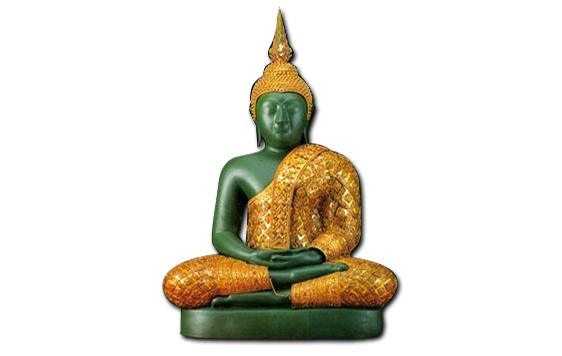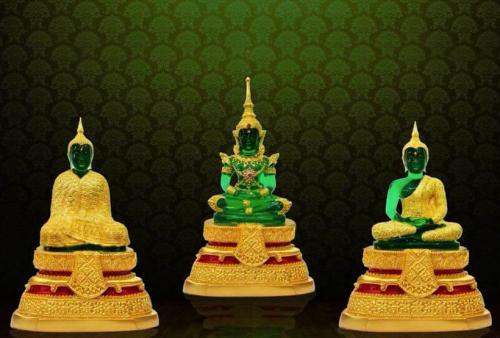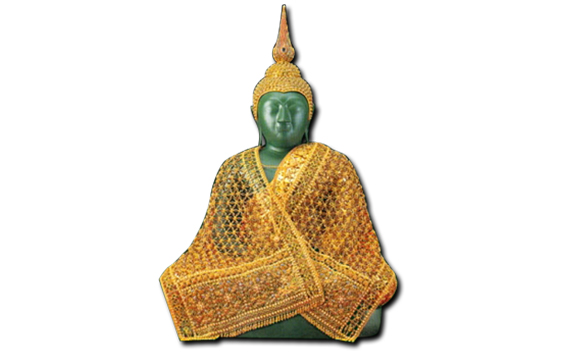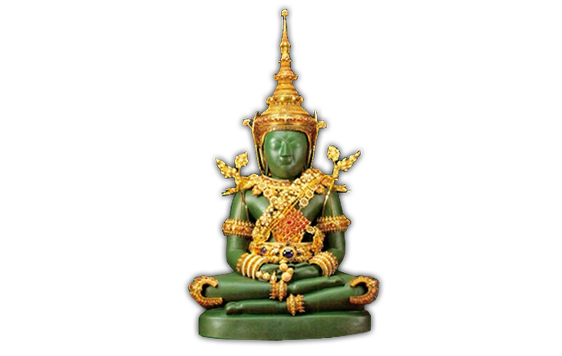If one asks of Thais which Buddha figure they hold in the highest regard, ninety percent of the responses would be "The Emerald Buddha”. This object of national veneration draws a huge crowd of Thais from all through The Kingdom to come in to pay respect as well as to admire the exceptional beauty of art and craftsmanship that is inherent in this most esteemed and revered of Buddha figures.
The Emerald Buddha
There is no clear evidence from where the Emerald Buddha originated. Legend has it that it was discovered in 1464 when lighting struck a pagoda of a temple in Chiang Rai and the figure covered with stucco was found inside. Sometime later the stucco was removed to reveal a beautiful Buddha figure made of a large piece of green jade.
The figure was carved in a seated position in the attitude of meditation. It is of 61 cm. height from base to top and has a knee span width of 1.90 meters. The figure was brought down to Lampang where it had remained for 32 years before King Tilok of Lannatai brought it to Chiang Mai where it was enshrined and venerated for 84 years.
Later on, the Lannatai line of succession became vacant and Prince Chaichettha of Luan Praban was invited to rule Chiang Mai. After a year, he decided to go back to Luan Praban to succeed his father as King of Laos. He took the Emerald Buddha with him and had enshrined it in Luang Prabang for another 12 years. When the king moved the capital city to Vientiane, the figure remained there for more than 200 years.
When Vientiane was captured by the Thais led by General Chakri in 1778, the Buddha was brought back to be kept in the Thonburi Kingdom until General Chakri succeeded King Taksin as King Rama I of the Chakri dynasty. The new King decided to rebuild a new capital at the east bank of the Chao Phraya River by recreating the once glorious old city of Ayudhaya. The new city was named "Krung Thep” or better known among foreigners as "Bangkok”. The King ordered the Grand Palace to be built together with the chapel royal to enshrine the Emerald Buddha.
The Emerald Buddha's AttireKing Rama I had the attires for summer and rainy season created for the Emerald Buddha as objects of worship. The winter attire was added later by King Rama III. The changing of the attire is held three times a year and is a royal ceremony performed by the king or the Crown Prince. The ceremony of changing to the summer attire is performed around March while the rainy season and winter attires are to be placed on to the Emerald Buddha around July and November respectively.
The New Attires of the Emerald Buddha

The New Attires of the Emerald Buddha
The attires of the Emerald Buddha deteriorated drastically after more than 200 years since they were created. The repairing and restoration of the attires to their original, glorious condition was considered impracticable, as it was created using magnificent craftsmanship and highly fine artwork of the old days which was difficult to combine with the new methods and techniques of today's craftsmanship.
a new set of the Emerald Buddha's
The Treasury Department deemed it appropriate to create a new set of the Emerald Buddha's attire to replace the original one which should be preserved as an invaluable national treasure and revered object of Buddha worship. This project was also designed as a tribute to His Majesty the King on the Golden Jubilee Celebration of His Majesty‘s Reign in 1996 and was with the joint cooperation of 6 organizations namely: Bureau of the Royal Household, Royal Goldsmith College, Asian Institute of Gemological Sciences, Jewelry and Thai Gems Trader Association, the Government Saving Bank and the Treasury Department.
The Project commenced in 1995 with the winter attire. The concept for the new attires was to create the new ones that are identical in all respects to the original ones. The creation of the new attires was completed in July 1997. The attires are now on display at the Pavillion of Regalia, Royal Decorations and Thai Coins and are on hand for the seasonally changing ceremony of the Emerald Buddha‘s attire.
The original attires are now well preserved under the custody of the Bureau of the Royal Household.



